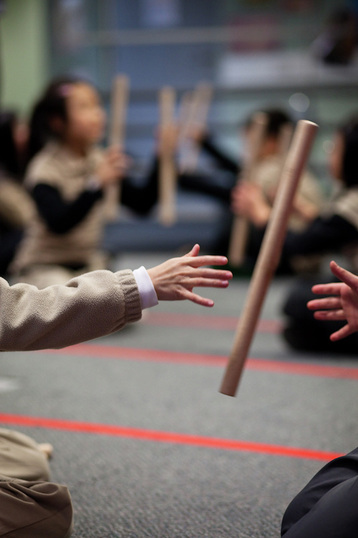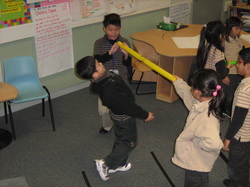Hola! Today in 4 DB we looked at a silly passing game from Latin America about dancing lemons! Part of the reason for the silliness of this game is because of the fact that it is about dancing lemons, but part of it is because of the fact that some of the words in the song are just made-up words that don’t mean anything (but are fun to sing!).
We don’t know how this game started, but we do think that it is from Latin America because of the language, and the mention of two famous Spanish dances – the rondella and the fandango, and because a few people in the class think that lemons are a very common fruit in Mexico!
The game is a passing game, where you pass an object around the circle on the beat – we started with one object but ended with everyone passing an object, so there were 28 ‘things’ being passed around at the same time – this was a little challenging, because if one person got even a little bit mixed up, it through the whole order of things! We had a lot of fun playing this nonetheless!
We also wondered if in the original game the objects passed around were lemons??
Here is a video of another group of students playing the game - look what happens at 'triki triki tron!'
Today we explored 'tī rakau' which are the sticks used in Maori stick games from New Zealand. Check out our videos and pictures from the class! To learn more about the stick game you can watch Mr. Muller's video in the 4AS blog or check out the Game Band under 'resources and home learning.'
Today we continued our inquiry into musical games by looking at a ring game from the African American culture in the USA. We discovered that this game was connected in several ways to the Caribbean game we learned last class because both games were developed by people who were brought to the countries as slaves. We also talked a lot about change, because even in our 50 minute musical class we discovered 2 different versions of playing this game. I wonder how many more versions of the game exist?A ring game is a game that is played in a circle; the circle symbolized equality and community - something that was very important to African American slaves.... and something that is also very important to us!
The game that we learned was called "Little Johnny Brown." Although we had a lot of fun playing this game, it does have quite a serious story behind it. The lyrics tell the story of Little Johnny Brown, who was a slave who picked cotton at a plantation. When he took his bag of cotton to his master to be weighed, the master said that the bag only weighed 20 lbs. Johnny knew that it weighed way more than that, and he was angry that his master was being dishonest, that following that day Johnny did everything he could to cheat his master; he put bricks, rocks, dead animals...anything heavy that he could find into his bag. When Johnny's mother found out, she asked Johnny to 'lay his blanket down' and dump the contents of the bag onto the blanket for her to see. She explained to Johnny that it is better to have an honest soul than to turn into a dishonest man like his master.
After reading the lyrics and talking about them, we decided that the song was about being honest and truthful at all costs - an important message.
The end of the song talks about buzzards (vultures) loping around, and we couldn't quite make sense of this, but after watching a video by Paula Larke (an African American Folklorist), we found this out:
The image of loping like a buzzard also refers to a tradition dating back to the days of slavery. Sometimes a slave would die in the field and get dragged off to the side so as not to slow down the work. At the end of the day, the other slaves would find their friend and perform a dance with the motions of a buzzard, escorting their friend’s spirit as it soared up to heaven.
This is also a game about taking risks and improvising because in the middle of the circle or ring is one person who can take the opportunity to 'show off' - they can dance and express themselves in any way they want to and the rest of us will copy their movment! If you want to see the actions for the game, have a look at our game bank
What a fun start to the New Year! Today in music we did two things; firstly, we made a list of all of the musical games that we already know of or have played before, and secondly, we had the chance to learn a new game from Trinidad and Tobago in the Caribbean.
Over the holidays, we had a chance to reflect and talk to our families and friends about musical games. This process has helped us to start a list of all the games we know as a year four group - so far our list is this:
Musical Chairs, Musical Statues, pass the parcel, skipping games with chants and songs, the limbo, London Bridge is falling down (UK), O Mochi O (Japan), Epapawairi/stick games (New Zealand), Poi Poi game (New Zealand), Kaka (Malaysia), hide the napkin, hot potato, guitar hero (video game), dance pad (video game), rock band (video game), apple on a stick, and musical guessing and memory games (echoing, listening, memory games).
We also did some reflecting about what exactly a musical game is. We came up with a list of 6 elements that we think a musical game MUST have to make it qualify as 'real' musical game. Here is our list:
1. shows or reflects different parts of a culture
2. must have music of some kind (singing, rhythm, beat, instruments, chant etc..)
3. must have rules and/or instructions
4. should be entertaining and does not need to have a winner
5. should have 2 or more players
6. has some kind of movement
The game that we played and learned about today was 'The Limbo." We discovered that some of us were already familiar with this game and have played at birthday parties and other social gatherings, but this was also a new game for others. We learned that this game originated in in Trinidad - a country in the Caribbean. We discovered that the English dialect (way of speaking) in Trinidad is quite different from the way we speak English, and we got to experience this dialect when learning the song "Poco 'le 'me 'lone" that we sang while doing the limbo.
Here are some quick facts that we discovered about the limbo:
- it was believed to be started by slaves who were brought to Trinidad from Africa on ships.
-it started as a dance, and then CHANGED into a game by adding rules and adding the limbo stick
- some people believe that the action of bending backwards is a symbol of the way slaves had to stand when put in the bottom part of the ship where the area was too low for them to stand straight up when they were being brought over to the Caribbean. This is only someones idea... we don't know if it is 100% true.
-the words in the song are sung in a different dialect of English - the words are shortened or different versions of the words we use (le me lone= leave me alone)
-the rules are that you must go under the bar by leaning backwards, you must not touch the floor with any part of your body except your feet, and you cannot touch the bar. We added the rule that you have to sing while you are waiting to go under, but you don't need to sing while you are actually going under.
-there is a winner and this person is the last person standing who has not touched the bar or the floor
-Even though this game started a long time ago in the Caribbean, it is connected to many other parts of the world because we think that it is probably a game that is played in many, many countries and cultures.
Next class, there will be a few girls from 4DB who will teach the class the musical game "apple on a stick."


 RSS Feed
RSS Feed